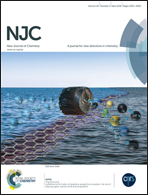Control-synthesized multilayer hyperbranched–hyperbranched polyethers with a tunable molecular weight and an invariant degree of branching†
Abstract
A strategy to synthesize multilayer hyperbranched–hyperbranched macromolecules with an invariant degree of branching (DB) and a controllable molecular weight (MW) is realized by taking advantages of competing reactions. The invariant DB and tunable MW lead to hyperbranched molecules with controlled sub-nano to nano pores, which have potential applications in supramolecular capsulation, gas storage, separation, and catalysis. Hyperbranched molecules with a low MW are obtained in a one-pot reaction due to the competing reactions between AB2 monomers. For our systems, hyperbranched molecules with much higher yet controlled MW can be achieved by adding additional batches of the same AB2 monomers. When different AB2 monomers with different spacer lengths are fed alternatively, multilayer core–shell hyperbranched macromolecules with a controlled layer thickness or MW are obtained. More importantly, the multilayer hyperbranched–hyperbranched macromolecules show not only tunable MW but also invariant DB. In addition, it is found that the Tg of core–shell hyperbranched molecules is mainly determined by the outermost layer.


 Please wait while we load your content...
Please wait while we load your content...